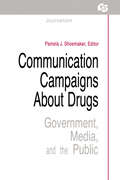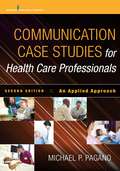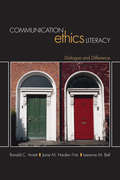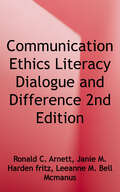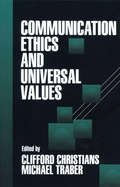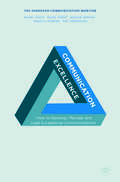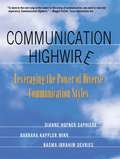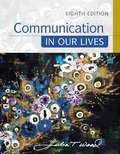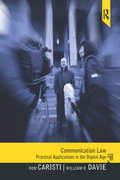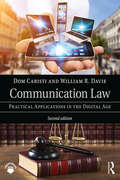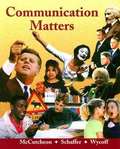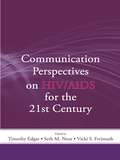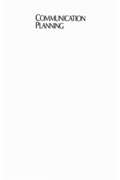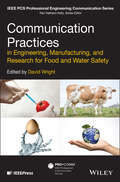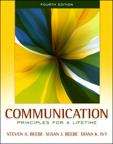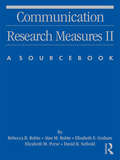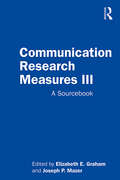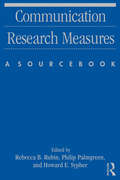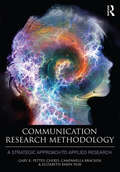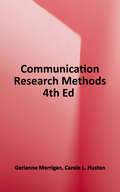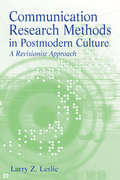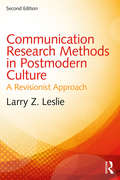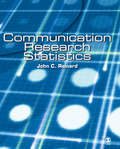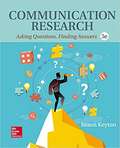- Table View
- List View
Communication Campaigns About Drugs: Government, Media, and the Public (Routledge Communication Series)
by Pamela J. ShoemakerPublished in 1989, Communication Campaigns About Drugs is a valuable contribution to the field of Communication Studies.
Communication Case Studies for Health Care Professionals: An Applied Approach
by Michael PaganoThe second edition builds on the first with the addition of 11 new cases and theoretical discussions of interpersonal, gender, intercultural, organizational, and media communication. Additionally, the new edition analyzes each scenario in detail to facilitate broader use by an inter professional team and expand awareness of the specific skills needed by each health care professional.
Communication Ethics Literacy: Dialogue and Difference
by Dr Ronald C. Arnett Dr Janie Fritz Dr Leeanne M. BellThis comprehensive and engaging treatment of communication ethics combines student application and theoretical engagement. Communication Ethics Literacy: Dialogue and Difference reviews classic communication ethics approaches and extends the conversation about dialogue and difference in public and private life. Introducing communication ethics as a pragmatic survival skill in a world of difference, the authors offer a learning model that frames communication ethics as arising from a set of goods found within particular narratives, traditions, or virtue structures that guide human life.
Communication Ethics Literacy: Dialogue and Difference
by Ronald C. Arnett Janie M. Harden Fritz Leeanne M. Bell McmanusCommunication ethics is imperative in the 21st century as the prevalence of conflicting opinions endangers successful, respectful communication. <p><p>Utilizing a dialogic approach to ethical communication, Communication Ethics Literacy: Dialogue and Difference provides a timely review of classic communication ethics literature and extends the conversation about dialogue and difference in public and private life. <p><p>Understanding communication ethics as a pragmatic survival skill in a world of difference, this work frames communication ethics as a discipline and practice that arises from multiple understandings of goods found across diverse narratives, traditions, and virtue structures that guide human life.
Communication Ethics and Universal Values
by Clifford G. Christians Dr Michael TraberThis volume is designed to revolutionize the field of communication by identifying a broad ethical theory which transcends the world of mass media practice to reveal a more humane and responsible code of values. The contributors, representing a diverse range of intercultural perspectives, defend the possibility of universal moral imperatives such as justice, reciprocity and human dignity. Through an examination of the values in which their cultures are grounded, they provide a short list of ethical principles which form the common ground from which to view contemporary issues in the media, interpersonal communication, mediation and conflict resolution.
Communication Excellence: How To Develop, Manage And Lead Exceptional Communications
by Ralph Tench Dejan Verčič Ansgar Zerfass Ángeles Moreno Piet VerhoevenExploring the implications of 10 years of data from more than 21,000 communication professionals across Europe, combined with case studies and interviews with senior communication directors from top European companies and organisations, this book provides an insight into how to build, develop and lead excellent communications. It presents a culmination of research and best practice models, covering strategic communication, the impact on reputation, crisis, mediatisation, organisational culture, new digital, social and mobile media as well as the development of professionalisation. Providing clear guidance on the difference between normal and excellent communication departments, the book shows readers how communication can effectively influence and support the organisation and positively fit within the business strategy of today's global and changing markets. The study behind this book, the European Communication Monitor, is known as the most comprehensive provider of reliable data in the communication field worldwide.
Communication Highwire: Leveraging The Power Of Diverse Communication Styles
by Barbara Kappler Mikk Basma Ibrahim Devries Dianne Hofner SaphiereNo matter where we live or what we do, we deal with people using a wide variety of communication styles every day. At work, in the marketplace and at home, diverse communication styles present opportunities for growth on the one hand, and misunderstanding on the other. Communication Highwire: Leveraging the Power of Diverse Communication Styles is an important breakthrough for managers, team leaders, community leaders, educators, trainers and facilitators as they work with individuals and teams to overcome frustrations, prevent mistakes and save time and money. World-class intercultural trainers and educators share their strategies, techniques and-most importantly-their tools for taking advantage of diversity in the modern world. Communication Highwire offers the following: twenty-six powerful activities, ready to go with a minimum of prep work; the debut of the Five-Factor Model (Context, Goals, Values, Self-Concept and Communication Style Repertoire), presented in an easy-to-use star chart; and dozens of examples that make concepts real and applicable.
Communication In Our Lives
by Julia WoodCOMMUNICATION IN OUR LIVES, 8th Edition, provides everything you need to become a more confident and effective communicator -- in both your personal and professional life. Award-winning teacher Julia T. Wood combines the latest research, theory, and best practices with hands-on skills development. Extremely student friendly, the text features an engaging, personal tone, while frequent Student Voice sections highlight how past students have experienced key communication concepts. <p><p> In addition to its signature emphasis on social and cultural diversity, the eighth edition includes expanded coverage of digital media, a new focus on health communication, and an early introduction to public speaking -- with plenty of sample speeches. The text also illustrates the importance of effective communication to today's careers. Interactive, online study tools help you put what you learn into practice as you strengthen your interpersonal, group, public speaking, and media skills.
Communication Law
by Michael Cavanaugh Dominic G Caristi William R DavieDebuting in its first edition, Communication Law is an engaging and accessible text that brings a fresh approach to the fundamentals of mass media law. Unique in its approach and its visually attractive design, this text differentiates itself from other current texts on the market while presenting students with key principles and landmark cases that establish and define communication law and regulation, providing a hands-on learning experience.
Communication Law: Practical Applications in the Digital Age
by William R Davie Dom CaristiNow in its second edition, Communication Law: Practical Applications in the Digital Age is an engaging and accessible text that brings a fresh approach to the fundamentals of mass media law. Designed for students of communication that are new to law, this volume presents its readers with key principles and emphasizes the impact of timely, landmark cases on today’s media world, providing an applied learning experience. This new edition offers a brand new chapter on digital media law, a wealth of new case studies, and expanded discussions of current political, social, and cultural issues.
Communication Law: Practical Applications in the Digital Age
by Dom Caristi Laurie Thomas Lee William R. DavieThis fully revised 4th edition brings a fresh approach to the fundamentals of mass media and communication law in an engaging and accessible way, keeping legal jargon to a minimum and highlighting real-life examples of legal conflicts.Designed for students of communication that are new to law, this volume presents key principles and emphasizes the impact of timely, landmark cases on today’s media world. Providing an applied learning experience, this new edition offers expanded coverage of telecommunications, digital media law, and social media. It presents discussions of contemporary political, social, and cultural issues such as artificial intelligence, surveillance, cybersecurity, revenge porn, deepfakes, and disinformation campaigns. To encourage critical thinking, chapters include “From the Trenches” vignettes written by practitioners, “Global View” pieces comparing U.S. status to that in other countries, and “Ethical Dilemmas” ideal for class discussion.Communication Law serves as a core textbook for undergraduate courses in communication and mass media law.Online resources for instructors, including an Instructor’s Manual, Test Bank, PowerPoint slides, and Timelines are available at: www.routledge.com/9781032612980.
Communication Matters
by James Schaffer Randall Mccutcheon Joseph R. WycoffDescribes how to research, organize, write, and deliver different kinds of speeches and discusses related forms of communication such as debates, oral interpretation, and radio.
Communication Perspectives on HIV/AIDS for the 21st Century (Routledge Communication Series)
by Seth M. Noar Timothy Edgar Vicki S. FreimuthReflecting the current state of research into the communication aspects of HIV/AIDS, this volume explores AIDS-related communication scholarship, moving forward from the 1992 publication AIDS: A Communication Perspective. Editors Timothy Edgar, Seth M. Noar, and Vicki S. Freimuth have developed this up-to-date collection to focus on today’s key communication issues in the HIV/AIDS epidemic. Chapters herein examine the interplay of the messages individuals receive about AIDS at the public level as well as the messages exchanged between individuals at the interpersonal level. Acknowledging how the face of HIV/AIDS has changed since 1992, the volume promotes the perspective that an understanding of effective communication through both mediated and interpersonal channels is essential to winning the continued battle against AIDS. Issues addressed here include: Social stigma associated with the disease, social support and those living with HIV/AIDS, and the current state of HIV testing Parent–child discussions surrounding HIV/AIDS and safer sexual behavior, and cultural sensitivity relating to developing HIV prevention and sex education programs The effectiveness of health campaigns to impact attitudes, norms, and behavior, as well as the current state of entertainment education and its ability to contribute to HIV prevention News media coverage of HIV/AIDS and the impact of the agenda-setting function on public opinion and policy making Health literacy and its importance to the health and well-being of those undergoing HIV treatment. The role of technological innovations, most notably the Internet, used for both prevention interventions as well as risky behavior The volume also includes exemplars that showcase the diversity of approaches to health communication used to combat the HIV/AIDS epidemic. These cases include interpersonal and mass communication mediums; traditional along with new media and technology; research by academics and practitioners; individual as well as community-based approaches; work based in the United States and internationally; and campaigns directed at at-risk, HIV- positive, as well as general populations. With new topics, new contributors, and a broadened scope, this book goes beyond a revision of the 1992 volume to reflect the current state of communication research on HIV/AIDS across key contexts. It is designed for academics, researchers, practitioners, and students in health communication, health psychology, and other areas of AIDS research. As a unique examination of communication research, it makes an indelible contribution to the growing knowledge base of communication approaches to combating HIV/AIDS.
Communication Planning: An Integrated Approach
by Sherry Devereaux FergusonThe nature of the communicator's job has changed dramatically over the last decade. While communicators still prepare speeches, press releases and articles for corporate magazines, they are now being asked to perform managerial duties such as planning, consulting stakeholders and advising CEO's and vice presidents. Communication Planning focuses on these additional responsibilities and examines the role of integrated planning in modern organizations. Sherry Ferguson's comprehensive study includes the theoretical foundations of communication planning and strategic approaches to planning for issues management.
Communication Practices in Engineering, Manufacturing, and Research for Food and Water Safety
by David Wright Traci Nathans-KellyThis book demonstrates some of the ways in which communication and developing technologies can improve global food and water safety by providing a historical background on outbreaks and public resistance, as well as generating interest in youth and potential professionals in the field History of muckraking in the food industry Case study on groundwater regulation Interviews with members of the beef industry and livestock market owners
Communication Principles for a Lifetime (4th edition)
by Susan J. Beebe Steven A. Beebe Diana K. IvyThe book provides readers with theory and skills in a manner that helps them apply what they've learned throughout their lives. Understanding that the challenge in communication is learning the myriad of skills, principles, and theories without being overwhelmed, Beebe, Beebe, and Ivy emphasize five key principles of communication throughout their book.
Communication Research Measures II: A Sourcebook (Routledge Communication Series)
by Rebecca B. Rubin Alan M Rubin Elizabeth M. Perse David Seibold Elizabeth E. GrahamExpanding and building on the measures included in the original 1994 volume, Communication Research Measures II: A Sourcebook provides new measures in mass, interpersonal, instructional, and group/organizational communication areas, and highlights work in newer subdisciplines in communication, including intercultural, family, and health. It also includes measures from outside the communication discipline that have been employed in communication research. The measures profiled here are "the best of the best" from the early 1990s through today. They are models for future scale development as well as tools for the trade, and they constitute the main tools that researchers can use for self-administered measurement of people's attitudes, conceptions of themselves, and perceptions of others. The focus is on up-to-date measures and the most recent scales and indexes used to assess communication variables. Providing suggestions for measurement of concepts of interest to researchers; inspiring students to consider research directions not considered previously; and supplying models for scale developers to follow in terms of the work necessary to produce a valid and reliable measurement instrument in the discipline, the authors of this key resource have developed a significant contribution toward improving measurement and providing measures for better science.
Communication Research Measures III: A Sourcebook (Routledge Communication Series)
by Elizabeth E. Graham Joseph P. MazerBuilding on the measures included in the original 1994 volume and subsequent 2009 volume, Communication Research Measures III: A Sourcebook extends its coverage of measurement issues and trends across the entire communication discipline. Volume III features entirely new content and offers an assessment of new measures in mass, interpersonal, instructional, group, organizational, family, health, and intercultural communication and highlights work in emergent subdisciplines in communication, including social media and new communication technologies, sports communication, and public relations. The “best of the best” from 2009 through today, the profiled research measures in Volume III serve as models for future scale development and constitute the main tools that researchers can use for self-administered measurement of people’s attitudes, conceptions of themselves, and perceptions of others. This book is ideal for undergraduate and graduate courses that emphasize quantitative research methods, measurement, and/or survey design across communication studies disciplines.
Communication Research Measures: A Sourcebook (Routledge Communication Series)
by Rebecca B. Rubin Howard E. Sypher Philip PalmgreenThe development of communication as a discipline has resulted in an explosion of scales tapping various aspects of interpersonal, mass, organizational, and instructional communication. This sourcebook brings together scales that measure a variety of important communication constructs. The scales presented are drawn from areas of interpersonal, mass, organizational, and instructional communication--areas in which the use of formal, quantitative scales is particularly well developed. Communication Research Measures reflects the recent important emphasis on developing and improving the measurement base of the communication discipline. It results in an equal amount of labor saved on the part of the scholars, students, and practitioners who find this book useful, and it contributes in a significant way to research efforts.Originally published by Guilford Press in 1994, now available from Routledge.
Communication Research Methodology: A Strategic Approach to Applied Research
by Cheryl Campanella Bracken Elizabeth B. Pask Gary PetteyThis introduction to communication research methods takes the student from the conceptual beginnings of a research project through the design and analysis. Emphasizing the correct questions to ask and how to approach the answers, authors Gary Petty, Cheryl Campanella Bracken, and Elizabeth Babin approach social science methods as a language to be learned, requiring multiple sessions and reinforcement through practice. They explain the basics of conducting communication research, facilitating students’ understanding of the operation and roles of research so that they can better critique and consume the materials in their classes and in the media. The book takes an applied methods approach, introducing students to the conceptual elements of communication science and then presenting these elements in a single study throughout the text, articulating the similarities and differences of individual methods along the way. The study is presented as a communication campaign, involving multiple methodologies. The approach highlights how one method can build upon another and emphasizes the fact that, given the nature of methodology, no single study can give complete answers to our research questions. Unique features of the text: It introduces students to research methods through a conceptual approach, and the authors demonstrate that the statistics are a tool of the concepts. It employs an accessible approach and casual voice to personalize the experience for the readers, leading them through the various stages and steps. The presentation of a communication campaign demonstrates each method discussed in the text. This campaign includes goals and objectives that will accompany the chapters, demonstrates each individual methodology, and includes research questions related to the communication campaign. The tools gained herein will enable students to review, use, understand, and critique research, including the various aspects of appropriateness, sophistication and utility of research they encounter.
Communication Research Methods
by Gerianne Merrigan Carole L. HustonIdeal for research methods courses covering multiple methodologies, Communication Research Methods is the only text that uses a research-as-argument approach to help students not only become more effective researchers, but more insightful consumers of research. Merrigan and Huston treat communication research comprehensively, discussing a broad range of traditional and contemporary methods and considering ethics in designing, conducting, and reporting research. NEW TO THIS EDITION The claims, data, and warrants chapters found in prior editions have been replaced with two new chapters that contextualise research arguments for quantitative social science (Ch. 4) and interpretive/critical research (Ch.11)A new chapter on interviews and focus groups (Ch. 12) will improve students' abilities to conduct interviews and code evidence based on repetition, recurrence, and forcefulness The ethics chapter (Ch. 3) now includes links to the ethical codes of conduct for 10 professional associations relevant to communication researchers in academia and industry Conversation Analysis (Ch. 10) and Discourse Analysis (Ch. 14), have been separated to more clearly represent the paradigmatic differences in those ways of studying language-in-use The chapter titles for all chapters in Parts II and III have been extended to help students more quickly compare those methods, and the text has been reorganised to match the first edition's order of paradigms All chapters include updated examples and more links to industry research. KEY FEATURES Each chapter begins with a short, reader-friendly introduction and student learning outcomes entitled 'What Will You Get from this Chapter? 'Shows students how research skills will matter in their roles at work, as consumers, parents, and voters, in healthcare and community contexts during school and after graduation Highlights the role of different methodologies for making different types of research arguments. This title is available as an eBook. Visit Vital Source for more information or to purchase.
Communication Research Methods in Postmodern Culture
by Larry Z LeslieCommunication Research Methods in Postmodern Culture explores communication research from a postmodern perspective while retaining key qualitative and quantitative research methods. The author uses easy-to-understand language to incorporate new research methods inspired by contemporary culture and includes review questions and suggested activities designed to help readers understand and master communication research. The blend of new and traditional methods creates a book appropriate to the study of communication in an increasingly complex cultural environment.
Communication Research Methods in Postmodern Culture: A Revisionist Approach
by Larry Z. LeslieThe second edition of Communication Research Methods in Postmodern Culture continues to explore research from a postmodern perspective. Typical qualitative and quantitative research methods are adjusted to fit the needs of contemporary culture. Each chapter is updated with new information and fresh examples. Included in the second edition is a new chapter on Internet and social media research. The author uses straightforward and easy-to-understand language. Both individual and group projects are among the suggested activities. This book is important for the study of communication in a changing political, social, economic, and technological environment.
Communication Research Statistics
by John C. ReinardWhile most books on statistics seem to be written as though targeting other statistics professors, John Reinard's Communication Research Statistics is especially impressive because it is clearly intended for the student reader, filled with unusually clear explanations and with illustrations on the use of SPSS. I enjoyed reading this lucid, student-friendly book and expect students will benefit enormously from its content and presentation. Well done!" --John C. Pollock, The College of New JerseyWritten in an accessible style using straightforward and direct language, Communication Research Statistics guides students through the statistics actually used in most empirical research undertaken in communication studies. This introductory textbook is the only work in communication that includes details on statistical analysis of data with a full set of data analysis instructions based on SPSS 12 and Excel XP.
Communication Research: Asking Questions, Finding Answers
by Joann KeytonCommunication Research: Asking Questions, Finding Answers covers basic research issues and processes, both quantitative and qualitative, appropriate for communication students with little or no previous research methods experience. The text's guiding principle is that methodological choices are made from one's research questions or hypotheses. This avoids the pitfall in which students learn one methodology or one methodological skill and then force that method to answer all types of questions. Instead of working with one methodology to answer all types of questions, students come away understanding a variety of methods and how to apply them appropriately.
